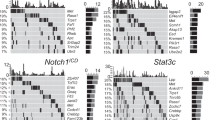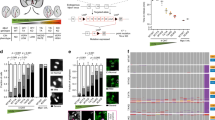Abstract
In mammals, loss of APC/Apc gatekeeper function initiates intestinal tumorigenesis. Several different mechanisms have been shown or proposed to mediate functional loss of APC/Apc: mutation in APC/Apc, non-disjunction, homologous somatic recombination and epigenetic silencing. The demonstration that, in the C57BL/6 (B6) ApcMin/+ mouse model of inherited intestinal cancer, loss of Apc function can occur by loss of heterozygosity (LOH) through somatic recombination between homologs presents an opportunity to search for polymorphisms in the homologous somatic recombination pathway. We report that the Robertsonian translocation Rb(7.18)9Lub (Rb9) suppresses the multiplicity of intestinal adenomas in this mouse model. As the copy number of Rb9 increases, the association with the interphase nucleolus of the rDNA repeats centromeric to the Apc locus on Chromosome 18 is increasingly disrupted. Our analysis shows that homologous somatic recombination is the principal pathway for LOH in adenomas in B6 ApcMin/+ mice. These studies provide additional evidence that neoplastic growth can initiate in the complete absence of canonical genomic instability.
This is a preview of subscription content, access via your institution
Access options
Subscribe to this journal
Receive 12 print issues and online access
$209.00 per year
only $17.42 per issue
Buy this article
- Purchase on Springer Link
- Instant access to full article PDF
Prices may be subject to local taxes which are calculated during checkout




Similar content being viewed by others
References
Fearnhead, N.S., Britton, M.P. & Bodmer, W.F. The ABC of APC. Hum. Mol. Genet. 10, 721–733 (2001).
Tucker, M., Goldstein, A., Dean, M. & Knudson, A. National Cancer Institute Workshop: the phakomatoses revisited. J. Natl. Cancer Inst. 92, 530–533 (2000).
Shoemaker, A.R., Gould, K.A., Luongo, C., Moser, A.R. & Dove, W.F. Studies of neoplasia in the Min mouse. Biochim. Biophys. Acta 1332, F25–F48 (1997).
Luongo, C., Moser, A.R., Gledhill, S. & Dove, W.F. Loss of Apc+ in intestinal adenomas from Min mice. Cancer Res. 54, 5947–5952 (1994).
Shoemaker, A.R. et al. A resistant genetic background leading to incomplete penetrance of intestinal neoplasia and reduced loss of heterozygosity in ApcMin/+ mice. Proc. Natl. Acad. Sci. USA 95, 10826–10831 (1998).
Haigis, K.M., Caya, J.G., Reichelderfer, M. & Dove, W.F. Intestinal adenomas can develop with a stable karyotype and stable microsatellites. Proc. Natl. Acad. Sci. USA 99, 8927–8931 (2002).
Robertson, W.M.R.B. Chromosome studies. I. Taxonomic relationship shown in the chromosomes of Tettegidae and Acrididiae: V-shaped chromosomes and their significance in Acrididiae, Locustidae and Grillidae: chromosome variations. J. Morphol. 27, 179–331 (1916).
Gropp, A. et al. Robertsonian karyotype variation in wild house mice from Rhaeto-Lombardia. Cytogenet. Cell Genet. 34, 67–77 (1982).
Lane, P.W. & Eicher, E.M. Location of plucked (pk) on chromosome 18 of the mouse. J. Hered. 76, 476–477 (1985).
Eppig, J.T. & Eicher, E.M. Analysis of recombination in the centromere region of mouse chromosome 7 using ovarian teratoma and backcross methods. J. Hered. 79, 425–429 (1988).
Wallace, B.M.N., Searle, J.B. & Everett, C.A. Male meiosis and gametogenesis in wild house mice (Mus musculus domesticus) from a chromosomal hybrid zone; a comparison between “simple” Robertsonian heterozygotes and homozygotes. Cytogenet. Cell Genet. 61, 211–220 (1992).
Davisson, M.T. & Akeson, E.C. Recombination suppression by heterozygous Robertsonian chromosomes in the mouse. Genetics 133, 649–667 (1993).
Dunnett, C.W. Pairwise multiple comparisons in homogeneous variance, unequal sample size case. J. Am. Stat. Assn. 75, 789–795 (1980).
Falconer, D.S. & Mackay, T.F.C. Introduction to Quantitative Genetics (Longman, Harlow, Essex, 1996).
Shoemaker, A.R. et al. Mlh1 deficiency enhances several phenotypes of ApcMin/+ mice. Oncogene 19, 2774–2779 (2000).
Gould, K.A., Dietrich, W.F., Borenstein, N., Lander, E.S. & Dove, W.F. Mom1 is a semi-dominant modifier of intestinal adenoma size and multiplicity in Min/+ mice. Genetics 144, 1769–1776 (1996).
Cormier, R.T. & Dove, W.F. Dnmt1N/+ reduces the net growth rate and multiplicity of intestinal adenomas in C57BL/6-multiple intestinal neoplasia (Min)/+ mice independently of p53 but demonstrates strong synergy with the modifier of Min-1 (AKR) resistance allele. Cancer Res. 60, 3965–3970 (2000).
Merritt, A.J., Gould, K.A. & Dove, W.F. Polyclonal structure of intestinal adenomas in ApcMin/+ mice with concomitant loss of Apc+ from all tumor lineages. Proc. Natl. Acad. Sci. USA 94, 13927–13931 (1997).
Novelli, M.R. et al. Polyclonal origin of colonic adenomas in an XO/XY patient with FAP. Science 272, 1187–1190 (1996).
Shao, C., Stambrook, P.J. & Tischfield, J.A. Mitotic recombination is suppressed by chromosomal divergence in hybrids of distantly related mouse strains. Nat. Genet. 28, 169–172 (2001).
Rothstein, R., Michel, B. & Gangloff, S. Replication fork pausing and recombination or “gimme a break.” Genes Dev. 14, 1–10 (2000).
Kuzminov, A. DNA replication meets genetic exchange: chromosomal damage and its repair by homologous recombination. Proc. Natl. Acad. Sci. USA 98, 8461–8468 (2001).
Luo, G. et al. Cancer predisposition caused by elevated mitotic recombination in Bloom mice. Nat. Genet. 26, 424–429 (2000).
Morrison, C. et al. Genetic interaction between PARP and DNA-PK in V(D)J recombination and tumorigenesis. Nat. Genet. 17, 479–482 (1997).
Shao, C. et al. Chromosome instability contributes to loss of heterozygosity in mice lacking p53. Proc. Natl. Acad. Sci. USA 97, 7405–7410 (2000).
Johnson, R.D. & Jasin, M. Double-strand-break-induced homologous recombination in mammalian cells. Biochem. Soc. Trans. 29, 196–201 (2001).
Turker, M.S. et al. Solid tissues removed from ATM homozygous deficient mice do not exhibit a mutator phenotype for second-step autosomal mutations. Cancer Res. 59, 4781–4783 (1999).
de Wind, N., Dekker, M., Berns, A., Radman, M. & te Riele, H. Inactivation of the mouse Msh2 gene results in mismatch repair deficiency, methylation tolerance, hyperrecombination, and predisposition to cancer. Cell 82, 321–330 (1995).
Merriam, J.R. & Garcia-Bellido, A. A model for somatic pairing derived from somatic crossing over with third chromosome rearrangements in Drosophila melanogaster. Mol. Gen. Genet. 115, 294–301 (1972).
Garcia-Bellido, A. & Wandosell, F. The effect of inversions on mitotic recombination in Drosophila melanogaster. Mol. Gen. Genet. 161, 317–321 (1978).
Silver, L.M. & Artzt, K. Recombination suppression of mouse t-haplotypes due to chromatin mismatching. Nature 290, 68–70 (1981).
Lengauer, C., Kinzler, K.W. & Vogelstein, B. Genetic instability in colorectal cancers. Nature 386, 623–627 (1997).
Marx, J. Debate surges over the origin of genomic defects in cancer. Science 297, 544–546 (2002).
Nielsen, J. & Wohlert, M. Chromosome abnormalities found among 34,910 newborn children: results from a 13-year incidence study in Arhus, Denmark. Hum. Genet. 87, 81–83 (1991).
Frydman, N. et al. Assisting reproduction of infertile men carrying a Robertsonian translocation. Hum. Reprod. 16, 2274–2277 (2001).
Brasch, J.M. & Smith, D.R. Absence of silver bands in human Robertsonian translocation chromosomes. Cytogenet. Cell Genet. 24, 122–125 (1979).
Hagstrom, S.A. & Dryja, T.P. Mitotic recombination map of 13cen–13q14 derived from an investigation of loss of heterozygosity in retinoblastoma. Proc. Natl. Acad. Sci. USA 96, 2952–2957 (1999).
Harbour, J.W. Molecular basis of low-penetrance retinoblastoma. Arch. Ophthalmol. 119, 1699–1704 (2001).
Shaffer, L.G. & Lupski, J.R. Molecular mechanisms for constitutional chromosomal rearrangements in humans. Annu. Rev. Genet. 34, 297–329 (2000).
Su, L.K. et al. Multiple intestinal neoplasia caused by a mutation in the murine homolog of the APC gene. Science 256, 668–670 (1992).
Davisson, M.T. & Akeson, E.C. An improved method for preparing G-banded chromosomes from mouse peripheral blood. Cytogenet. Cell Genet. 45, 70–74 (1987).
Jacoby, R.F. et al. A juvenile polyposis tumor suppressor locus at 10q22 is deleted from non-epithelial cells in the lamina propria. Gastroenterology 112, 1398–1403 (1997).
Bridger, J.M., Herrmann, H., Münkel, C. & Lichter, P. Identification of an interchromosomal compartment by polymerization of nuclear-targeted vimentin. J. Cell Sci. 111, 1241–1253 (1998).
Acknowledgements
We dedicate this work to the memory of G. Pontecorvo, who insisted long ago on the importance of somatic recombination for mammalian genetics. The authors thank M. Haigis, L. Clipson, N. Drinkwater, A. Shedlovsky, R. Halberg and I. Riegel for critical reading of the manuscript; M. Newton for the statistical analysis in Web Note A; D. Threadgill for insightful discourse; C. Alexander for the gift of mouse embryonic fibroblasts; and J. Weeks and H. Edwards for histological preparations. This work was supported by grants from the US National Cancer Institute. K.M.H. was supported by a predoctoral training grant from the US National Institutes of Health. This is publication No. 3607 from the Laboratory of Genetics.
Author information
Authors and Affiliations
Corresponding author
Ethics declarations
Competing interests
The authors declare no competing financial interests.
Supplementary information
Rights and permissions
About this article
Cite this article
Haigis, K., Dove, W. A Robertsonian translocation suppresses a somatic recombination pathway to loss of heterozygosity. Nat Genet 33, 33–39 (2003). https://doi.org/10.1038/ng1055
Received:
Accepted:
Published:
Issue Date:
DOI: https://doi.org/10.1038/ng1055
This article is cited by
-
Degree and site of chromosomal instability define its oncogenic potential
Nature Communications (2020)
-
Generation of renewable mouse intestinal epithelial cell monolayers and organoids for functional analyses
BMC Cell Biology (2018)
-
β-Catenin signaling dosage dictates tissue-specific tumor predisposition in Apc-driven cancer
Oncogene (2013)
-
Contribution of the 15 amino acid repeats of truncated APC to β-catenin degradation and selection of APC mutations in colorectal tumours from FAP patients
Oncogene (2010)
-
Role of bone marrow-derived cells in colon cancer: lessons from mouse model studies
Journal of Gastroenterology (2009)



